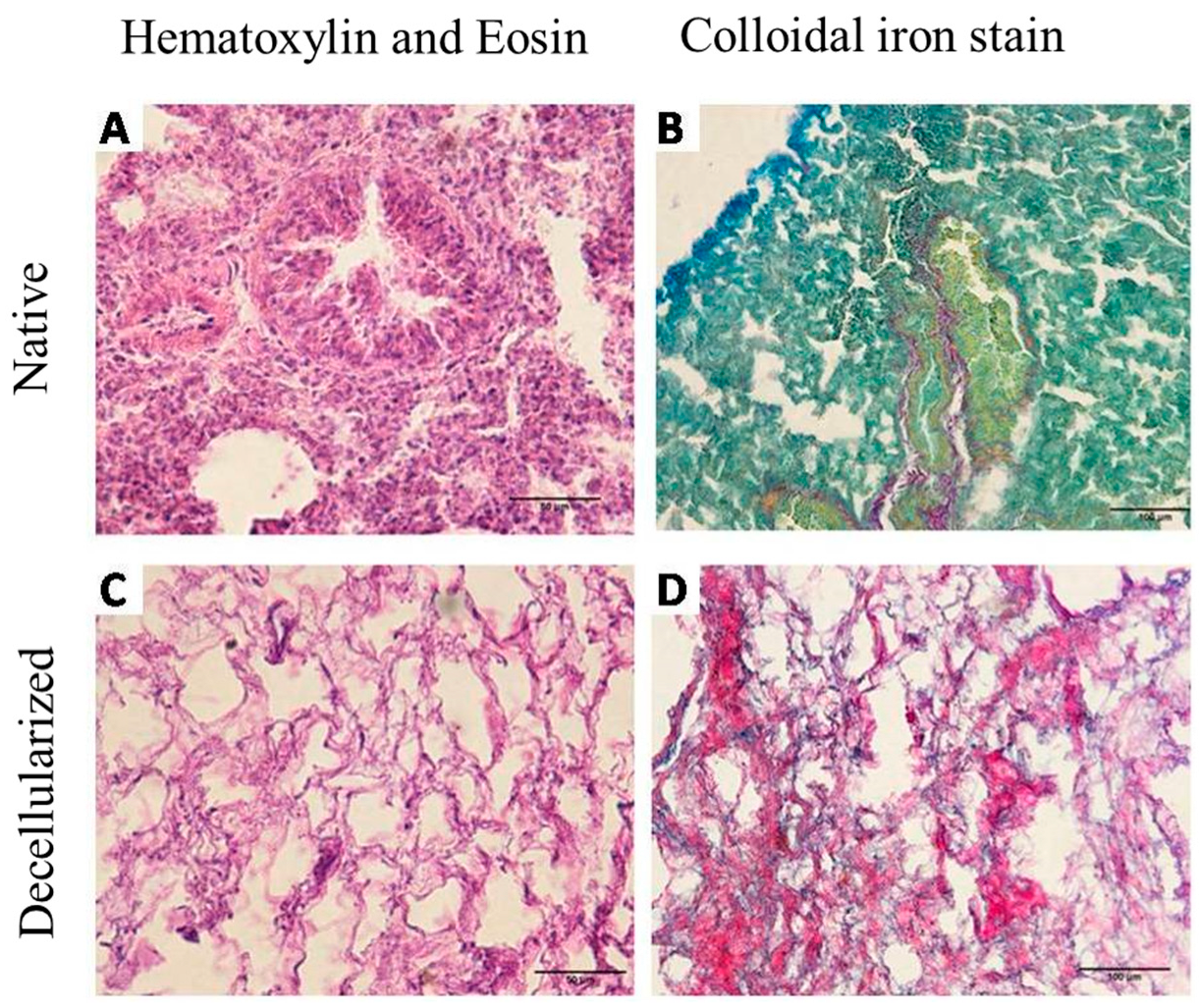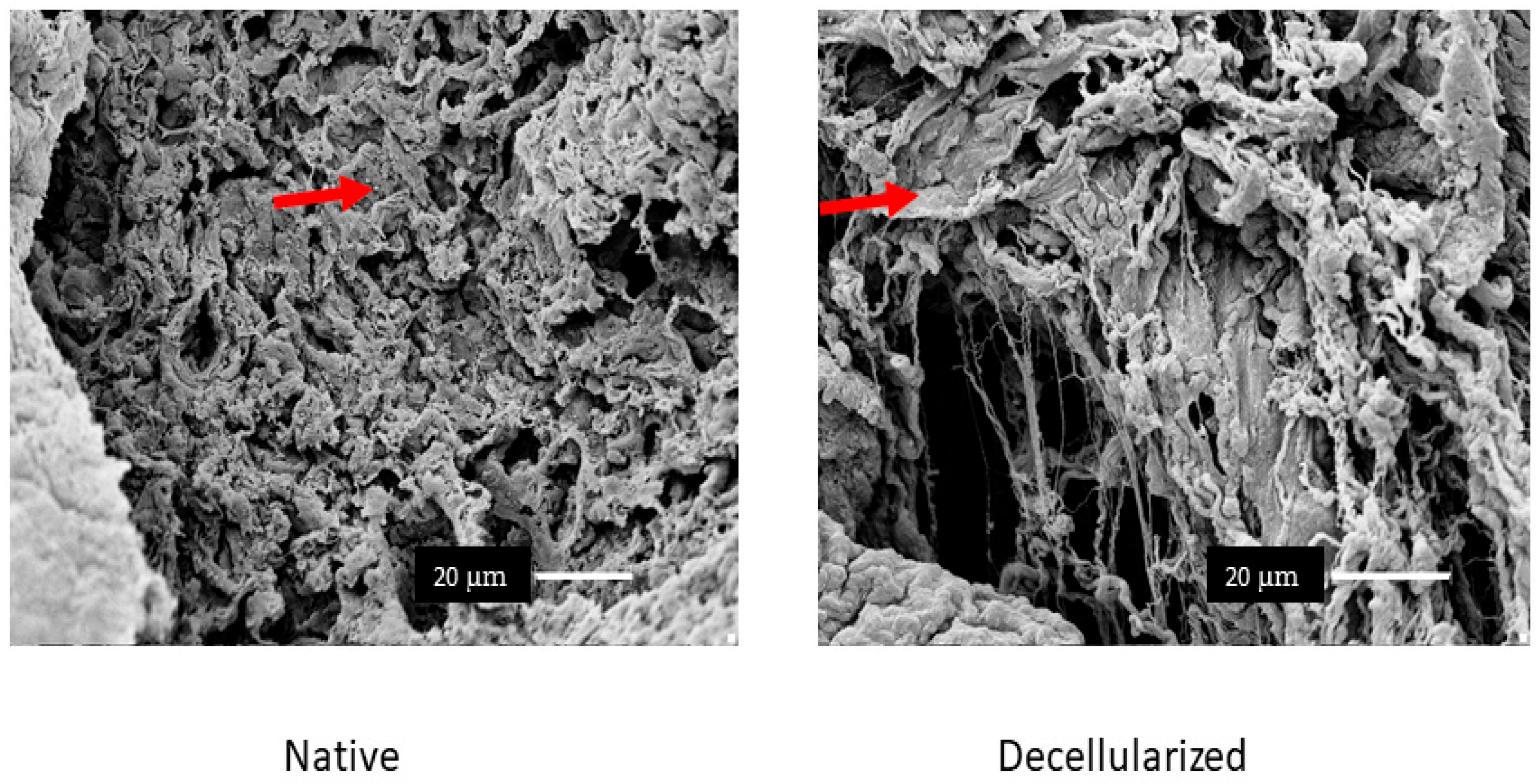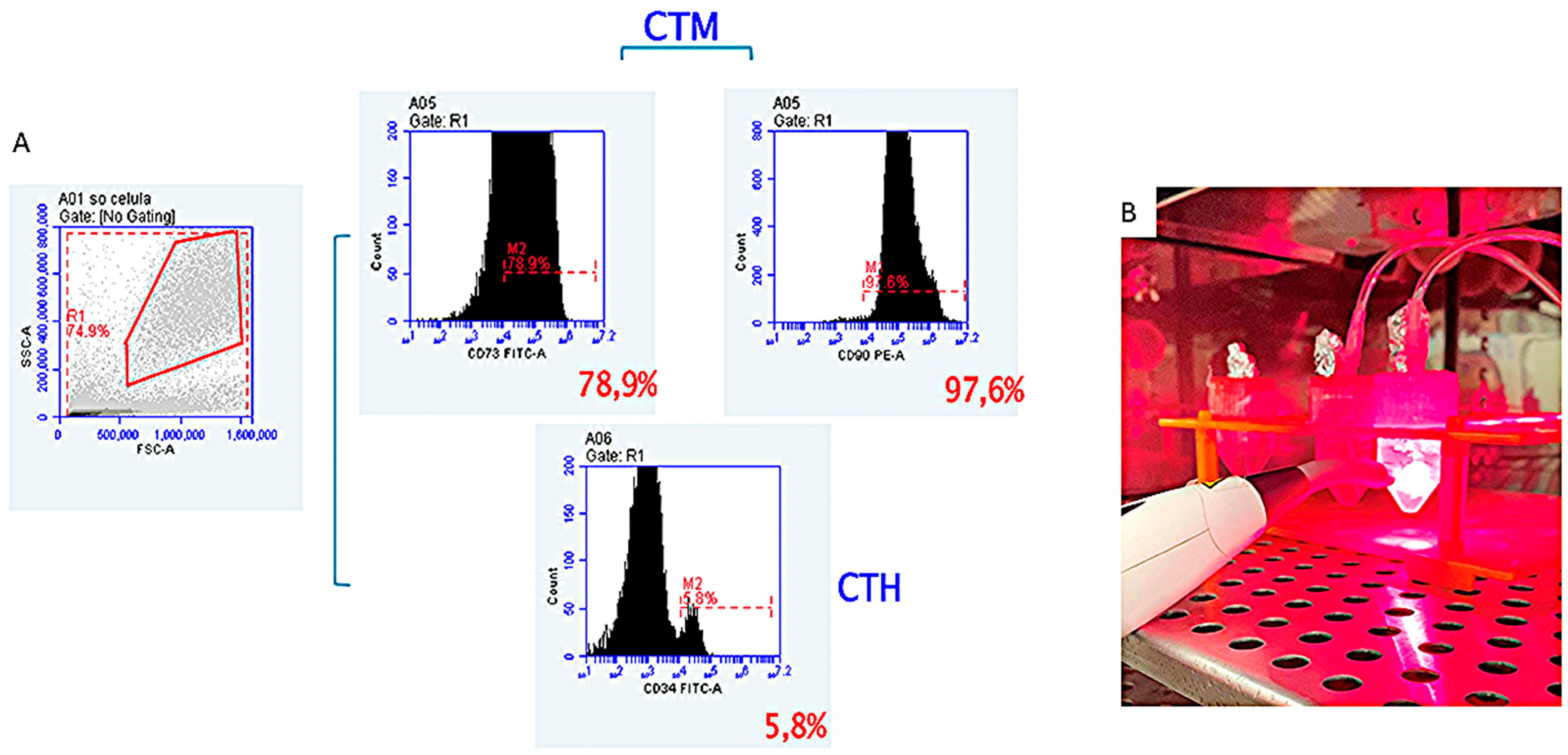Enhancing Lung Recellularization with Mesenchymal Stem Cells via Photobiomodulation Therapy: Insights into Cytokine Modulation and Sterilization
Abstract
1. Introduction
2. Results
2.1. Decellularization Assessment
2.2. Lung Scaffold Recellularization
3. Discussion
4. Materials and Methods
4.1. Lung Decellularization
4.2. Histological and Immunohistochemistry Analysis of Samples
4.3. Scanning Electron Microscopy (SEM)
4.4. Quantification of DNA in Decellularized Lungs
4.5. Isolation and Culture of Dental Pulp Stem Cells (DPSCs)
4.6. Characterization of Dental Pulp Stem Cells (DPSCs)
4.7. Cultivation of DPSCs in Decellularized Lungs
4.8. Evaluation of Cytokine Levels by ELISA
4.9. Statistical Analysis
5. Conclusions
Author Contributions
Funding
Institutional Review Board Statement
Informed Consent Statement
Data Availability Statement
Acknowledgments
Conflicts of Interest
References
- Shin’oka, T.; Imai, Y.; Ikada, Y. Trasplantation of a tissue- engineered pulmonary artery. N. Engl. J. Med. 2001, 344, 532–533. [Google Scholar] [CrossRef] [PubMed]
- Yusen, R.D.; Shearon, T.H.; Qian, Y.; Kotloff, R.; Barr, M.L.; Sweet, S.; Dyke, D.B.; Murray, S. Lung transplantation in the United States, 1999–2008. Am. J. Transplant. 2010, 10, 1047–1106. [Google Scholar] [CrossRef] [PubMed]
- Nichols, J.E.; Cortiella, J. Engineering of a Complex Organ: Progress Toward Development of a Tissue-Engineered Lung. Proc. Am. Thorac. Soc. 2008, 5, 723–730. [Google Scholar] [CrossRef] [PubMed]
- Prakash, Y.S.; Tschumperlin, D.J.; Stenmark, K.R. Bioengineering the Lung: Molecules, Materials, Matrix, Morphology, and Mechanics. Am. J. Physiol.-Lung Cell. Mol. Physiol. 2015, 309, L625–L638. [Google Scholar] [CrossRef] [PubMed]
- Petersen, T.H.; Calle, E.A.; Zhao, L.; Lee, E.J.; Gui, L.; Raredon, M.B.; Gavrilov, K.; Yi, T.; Zhuang, Z.W.; Breuer, C.; et al. Tissue-engineered lungs for in vivo implantation. Science 2010, 329, 538–541. [Google Scholar] [CrossRef]
- Price, A.P.; England, K.A.; Matson, A.M.; Blazar, B.R.; Panoskaltsis-Mortari, A. Development of a Decellularized Lung Bioreactor System for Bioengineering the Lung: The Matrix Reloaded. Tissue Eng. Part A 2010, 16, 2581–2591. [Google Scholar] [CrossRef]
- Ott, H.C.; Clippinger, B.; Conrad, C.; Schuetz, C.; Pomerantseva, I.; Ikonomou, L.; Kotton, D.; Vacanti, J.P. Regeneration and Orthotopic Transplantation of a Bioartificial Lung. Nat. Med. 2010, 16, 927–933. [Google Scholar] [CrossRef]
- Gilpin, S.E.; Charest, J.M.; Ren, X.; Ott, H.C. Bioengineerring lungs for transplantation. Thorac. Surg. Clin. 2016, 26, 163–171. [Google Scholar] [CrossRef]
- Stanko, P.; Altanerova, U.; Jakubechova, J.; Repiska, V.; Altaner, C. Dental Mesenchymal Stem/Stromal Cells and Their Exosomes. Stem Cells Int. 2018, 2018, 8973613. [Google Scholar] [CrossRef]
- Gilpin, S.E.; Wagner, D.E. Acellular human lung scaffolds to model lung disease and tissue regeneration. Eur. Respir. Rev. 2018, 27, 180021. [Google Scholar] [CrossRef]
- Uriarte, J.J.; Nonaka, P.N.; Campillo, N.; Palma, R.K.; Melo, E.; de Oliveira, L.V.; Navajas, D.; Farré, R. Mechanical properties of acellular mouse lungs after sterilization by gamma irradiation. J. Mech. Behav. Biomed. Mater. 2014, 40, 168–177. [Google Scholar] [CrossRef] [PubMed]
- Smith, L.R.; Cho, S.; Discher, D.E. Stem Cell Differentiation Is Regulated by Extracellular Matrix Mechanics. Physiology 2018, 33, 16–25. [Google Scholar] [CrossRef]
- Ahrabi, B.; Tavirani, M.R.; Khoramgah, M.S.; Noroozian, M.; Darabi, S.; Khoshsirat, S.; Abbaszadeh, H.A. The Effect of Photobiomodulation Therapy on the Differentiation, Proliferation, and Migration of the Mesenchymal Stem Cell: A Review. J. Lasers Med. Sci. 2019, 10 (Suppl. S1), S96–S103. [Google Scholar] [CrossRef] [PubMed]
- Aimbire, F.; Ligeiro de Oliveira, A.P.; Albertini, R.; Corrêa, J.C.; Ladeira de Campos, C.B.; Lyon, J.P.; Silva, J.A.; Costa, M.S. Low level laser therapy (LLLT) decreases pulmonary microvascular leakage, neutrophil influx and IL-1beta levels in airway and lung from rat subjected to LPS-induced inflammation. Inflammation 2008, 31, 189–197. [Google Scholar] [CrossRef] [PubMed]
- Pasternak-Mnich, K.; Ziemba, B.; Szwed, A.; Kopacz, K.; Synder, M.; Bryszewska, M.; Kujawa, J. Effect of Photobiomodulation Therapy on the Increase of Viability and Proliferation of Human Mesenchymal Stem Cells. Lasers Surg. Med. 2019, 51, 824–833. [Google Scholar] [CrossRef] [PubMed]
- Diker, N.; Aytac, D.; Helvacioglu, F.; Oguz, Y. Comparative effects of photobiomodulation therapy at wavelengths of 660 and 808 nm on regeneration of inferior alveolar nerve in rats following crush injury. Lasers Med. Sci. 2020, 35, 413–420. [Google Scholar] [CrossRef]
- Crapo, P.M.; Gilbert, T.W.; Stephen, F.B. An overview of tissue and whole organ decellularization processes. Biomateriais 2011, 32, 3233–3243. [Google Scholar] [CrossRef]
- Da Palma, R.K.; Campillo, N.; Uriarte, J.J.; Oliveira, L.V.; Navajas, D.; Farré, R. Pressure- and Flow-Controlled Media Perfusion Differently Modify Vascular Mechanics in Lung Decellularization. J. Mech. Behav. Biomed. Mater. 2015, 49, 69–79. [Google Scholar] [CrossRef]
- Melo, E.; Garreta, E.; Luque, T.; Cortiella, J.; Nichols, J.; Navajas, D.; Farré, R. Effects of the decellularization method on the local stiffness of acellular lungs. Tissue Eng. Part C Methods 2014, 20, 412–422. [Google Scholar] [CrossRef]
- Bonenfant, N.R.; Sokocevic, D.; Wagner, D.E.; Borg, Z.D.; Lathrop, M.J.; Lam, Y.W.; Deng, B.; DeSarno, M.J.; Ashikaga, T.; Loi, R.; et al. The effects of storage and sterilization on decellularized and recellularized whole lung. Biomaterials 2013, 34, 3231–3245. [Google Scholar] [CrossRef]
- Scarritt, M.E.; Bonvillain, R.W.; Burkett, B.J.; Wang, G.; Glotser, E.Y.; Zhang, Q.; Sammarco, M.C.; Betancourt, A.M.; Sullivan, D.E.; Bunnell, B.A. Hypertensive rat lungs retain hallmarks of vascular disease upon decellularization but support the growth of mesenchymal stem cells. Tissue Eng. Part A 2014, 20, 1426–1443. [Google Scholar] [CrossRef] [PubMed]
- Carreras, A.; Rojas, M.; Tsapikouni, T.; Montserrat, J.M.; Navajas, D.; Farré, R. Obstructive apnea induce early active action of mesenchymal stem cells and enhancement of endothelial wound healing. Respir. Res. 2010, 11, 91. [Google Scholar] [CrossRef] [PubMed]
- Gouk, S.; Lim, T.; Teoh, S.; Sun, W.Q. Alterations of human acellular tissue matrix by gamma irradiation: Histology, biomechanical property, stability, in vitro cell repopulation, and remodeling. Biomater. J. Biomed. Mater. Res. B Appl. 2008, 84, 205–217. [Google Scholar] [CrossRef] [PubMed]
- McGilvray, K.C.; Santoni, B.G.; Turner, A.S.; Bogdansky, S.; Wheeler, D.L.; Puttlitz, C.M. Effects of 60Co gamma radiation dose on initial structural biomechanical properties of ovine bone–patellar tendon–bone allografts. Cell Tissue Bank. 2011, 12, 89–98. [Google Scholar] [CrossRef]
- Peron, J.P.S.; de Brito, A.A.; Pelatti, M.; Brandao, W.N.; Vitoretti, L.B.; Greiffo, F.R.; da Silveira, E.C.; Oliveira-Junior, M.C.; Maluf, M.; Evangelista, L.; et al. Human tubal derived mesenchymal stromal cells associated with low level laser therapy significantly reduces cigarette smoke-induced COPD in C57 BL/6 mice. PLoS ONE 2015, 10, e0136942. [Google Scholar]
- Moraes, G.d.C.; Vitoretti, L.B.; de Brito, A.A.; Alves, C.E.; de Oliveira, N.C.R.; Dias, A.d.S.; Matos, Y.S.T.; Oliveira-Junior, M.C.; Oliveira, L.V.F.; da Palma, R.K.; et al. Low-Level Laser Therapy Reduces Lung Inflammation in an Experimental Model of Chronic Obstructive Pulmonary Disease Involving P2X7 Receptor. Oxidative Med. Cell. Longev. 2018, 2018, 6798238. [Google Scholar] [CrossRef]
- da Palma, R.K.; Nonaka, P.N.; Campillo, N.; Uriarte, J.J.; Urbano, J.J.; Navajas, D.; Farré, R.; Oliveira, L.V. Behavior of vascular resistance undergoing various pressure insufflation and perfusion on decellularized lungs. J. Biomech. 2016, 49, 1230–1232. [Google Scholar] [CrossRef]
- Gronthos, S.; Mankani, M.; Brahim, J.; Robey, P.G.; Shi, S. Postnatal human dental pulp stem cells (DPSCs) in vitro and in vivo. Proc. Natl. Acad. Sci. USA 2000, 97, 13625–13630. [Google Scholar] [CrossRef]
- Campagnoli, C.; Roberts, I.A.G.; Kumar, S.; Bennett, P.R.; Bellantuono, I.; Fisk, N.M. Identification of mesenchymal stem/progenitor cells in human first-trimester fetal blood, liver, and bone marrow. Blood 2001, 98, 2396–2402. [Google Scholar] [CrossRef]
- Uhl, F.E.; Zhang, F.; Pouliot, R.A.; Uriarte, J.J.; Enes, S.R.; Han, X.; Ouyang, Y.; Xia, K.; Westergren-Thorsson, G.; Malmström, A.; et al. Functional role of glycosaminoglycans in decellularized lung extracellular matrix. Acta Biomater. 2020, 102, 231–246. [Google Scholar] [CrossRef]






Disclaimer/Publisher’s Note: The statements, opinions and data contained in all publications are solely those of the individual author(s) and contributor(s) and not of MDPI and/or the editor(s). MDPI and/or the editor(s) disclaim responsibility for any injury to people or property resulting from any ideas, methods, instructions or products referred to in the content. |
© 2024 by the authors. Licensee MDPI, Basel, Switzerland. This article is an open access article distributed under the terms and conditions of the Creative Commons Attribution (CC BY) license (https://creativecommons.org/licenses/by/4.0/).
Share and Cite
Guimarães, L.L.; Brito, A.A.; Cereta, A.D.; Oliveira, A.P.L.; Afonso, J.P.R.; Mello, D.A.C.P.G.; Oliveira-Silva, I.; Silva, C.H.M.; Oliveira, R.F.; Oliveira, D.A.A.P.; et al. Enhancing Lung Recellularization with Mesenchymal Stem Cells via Photobiomodulation Therapy: Insights into Cytokine Modulation and Sterilization. Int. J. Mol. Sci. 2024, 25, 10131. https://doi.org/10.3390/ijms251810131
Guimarães LL, Brito AA, Cereta AD, Oliveira APL, Afonso JPR, Mello DACPG, Oliveira-Silva I, Silva CHM, Oliveira RF, Oliveira DAAP, et al. Enhancing Lung Recellularization with Mesenchymal Stem Cells via Photobiomodulation Therapy: Insights into Cytokine Modulation and Sterilization. International Journal of Molecular Sciences. 2024; 25(18):10131. https://doi.org/10.3390/ijms251810131
Chicago/Turabian StyleGuimarães, Leticia L., Auriléia A. Brito, Andressa D. Cereta, Ana Paula L. Oliveira, João Pedro R. Afonso, Diego A. C. P. G. Mello, Iransé Oliveira-Silva, Carlos H. M. Silva, Rodrigo F. Oliveira, Deise A. A. P. Oliveira, and et al. 2024. "Enhancing Lung Recellularization with Mesenchymal Stem Cells via Photobiomodulation Therapy: Insights into Cytokine Modulation and Sterilization" International Journal of Molecular Sciences 25, no. 18: 10131. https://doi.org/10.3390/ijms251810131
APA StyleGuimarães, L. L., Brito, A. A., Cereta, A. D., Oliveira, A. P. L., Afonso, J. P. R., Mello, D. A. C. P. G., Oliveira-Silva, I., Silva, C. H. M., Oliveira, R. F., Oliveira, D. A. A. P., Vieira, R. d. P., Santos, D. B., Insalaco, G., Oliveira, L. V. F., & da Palma, R. K. (2024). Enhancing Lung Recellularization with Mesenchymal Stem Cells via Photobiomodulation Therapy: Insights into Cytokine Modulation and Sterilization. International Journal of Molecular Sciences, 25(18), 10131. https://doi.org/10.3390/ijms251810131







